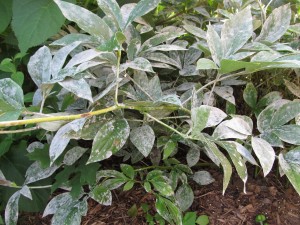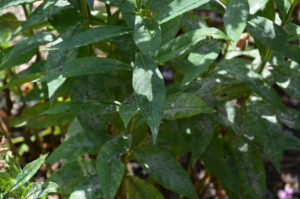Gardeners have learned to associate certain plants with a troublesome disease(s). Powdery and downy mildews have become epidemic in many regions of the U.S. Best ways for managing mildew diseases are prevention, good cultural practices, and spraying.. First, avoid planting susceptible cultivars. Plant in the proper location and space plants far enough apart so they’re not touching. Surrounding vegetation should not block air movement through the garden.
Follow good cultural practices such as reducing or eliminating overhead irrigation practices. Fertilize to optimize plant health, but avoid over-fertilization with nitrogen as it stimulates young, succulent growth which can be more susceptible to infection.
Some moderately susceptible cultivars may require protection with fungicide sprays, particularly if environmental conditions are highly favorable for onset of mildew diseases. Dig up and eliminate susceptible cultivars of lilac, roses, crape myrtle, impatiens, zinnias or summer phloxes. Plant breeders continue to provide gardeners with better disease resistant cultivars. In recent years, notable examples of resistant plants include:
Crape myrtles – ‘Catawba’, ‘Hopi’, ‘Cherokee’
Crabapples – ‘Prairifire’, ‘Sugar Tyme’, lots others
Dogwood (Cornus florida)– ‘Cherokee Brave’, ‘Appalachian Joy’, ‘Appalachian Snow’, ‘Appalachian Mist’
Dogwood hybrids (C. florida x C. kousa) – ‘Stellar Pink’, ‘Stardust’, ‘Galaxy’, ‘Constellation’ , ‘Aurora’
Sycamore – ‘Columbia’, ‘Liberty’, Yarwood, Exclamation™
Summer phlox – ‘David’, ‘Robert Poore’, ‘Delta Snow’, ‘Speed Limit 45’
Lilac – ‘Bloomerang’, ‘Betsy Ross’, S. meyeri ‘Miss Kim’, S. pekinensis
Monardas (beebalm) – ‘Marshall’s Delight’, ‘Blaustrumph’, ‘Colrain Red’.
Rhododendrons – R. yakushimanum, R. macrophyllum, R. ‘Nova Zembla,’ R. ‘Palestrina’
Roses – Simplicity™ and Meidiland™ roses, Rosa rugosa varieties
Zinnias – Z. angustifolius ‘Profusion or Zahara series; Pulcino and African varieties
One final thought: if foliage infections break out on garden plants in very late summer or fall, spraying a preventative fungicide is generally not necessary or impractical. Instead, practice good garden sanitation, a thorough clean-up of infected leaves and stems. For infected annuals and perennials, gather up infected debris and discard. Do not add it to a compost pile, but throw it curbside for pickup or add to a burn pile, obtaining the proper burn permits.



 Posted in
Posted in 
